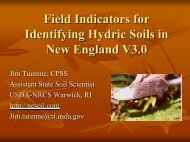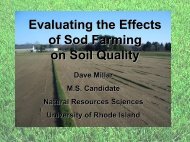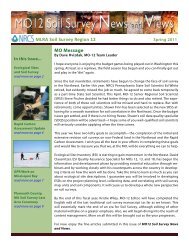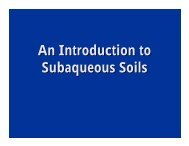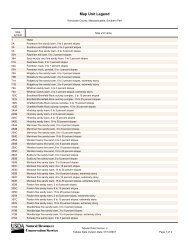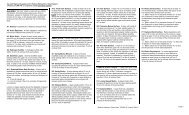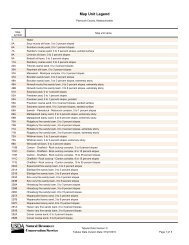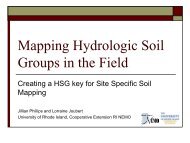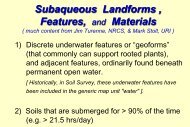Demas, Rabenhorst, 1999 Pedogenesis in submerged ... - NeSoil
Demas, Rabenhorst, 1999 Pedogenesis in submerged ... - NeSoil
Demas, Rabenhorst, 1999 Pedogenesis in submerged ... - NeSoil
Create successful ePaper yourself
Turn your PDF publications into a flip-book with our unique Google optimized e-Paper software.
Subaqueous Soils: <strong>Pedogenesis</strong> <strong>in</strong> a Submersed Environment<br />
George P. <strong>Demas</strong>* and Mart<strong>in</strong> C. <strong>Rabenhorst</strong><br />
ABSTRACT and sediment parameters is difficult to determ<strong>in</strong>e. To<br />
Proposals for the <strong>in</strong>clusion of permanently submersed materials<br />
<strong>in</strong> soil taxonomic systems have periodically been put forth s<strong>in</strong>ce some<br />
time <strong>in</strong> the mid 1800s. The proposals were largely conceptual <strong>in</strong> nature,<br />
apply a new approach, a pedological approach, it is<br />
necessary to demonstrate that shallow water sediments<br />
can be described by a pedological paradigm.<br />
rely<strong>in</strong>g more on subjective reason<strong>in</strong>g rather than analytical and field S<strong>in</strong>ce the <strong>in</strong>ception of pedological research, debate<br />
data. Advances <strong>in</strong> computer and global position<strong>in</strong>g technology, and concern<strong>in</strong>g the <strong>in</strong>clusion of subaqueous materials <strong>in</strong> soil<br />
the cont<strong>in</strong>u<strong>in</strong>g development of the discipl<strong>in</strong>e of pedology provided<br />
the opportunity to exam<strong>in</strong>e shallow water estuar<strong>in</strong>e sediments with<strong>in</strong><br />
a pedological framework. Morphological and analytical data from 85<br />
1.5- to 2.0-m profiles from S<strong>in</strong>epuxent Bay, Maryland, <strong>in</strong>dicate that<br />
the four pedogenic processes of additions, losses, transformations,<br />
and transfers outl<strong>in</strong>ed <strong>in</strong> the generalized theory of soil genesis are<br />
active <strong>in</strong> a subaqueous environment. The evidence of pedogenic processes<br />
<strong>in</strong>cludes the addition of biogenic calcium carbonate (shells),<br />
organic fragments, and organic matter; the loss of organic matter<br />
taxonomic systems has arisen periodically (v.Post, 1862;<br />
Kubiena, 1948; Arbeitskries Bodensystematik, 1985).<br />
The question at the center of the debate seems to be<br />
related to the concepts of the “upper limit” of soil and<br />
the scientific def<strong>in</strong>ition of soil. Many pedologists believe<br />
that the upper limit of soil must be the atmosphere<br />
(Nikiforoff, 1958; Simonson, 1959; Foth, 1978), while <strong>in</strong><br />
other cases the boundary is considered to <strong>in</strong>clude shal-<br />
and surficial material; the transfer of oxygen through diffusion and low water (Kubiena, 1953; Goldschmidt, 1958; Muckenbioturbation<br />
processes; and the transformation of humic substances hausen, 1965; Ponnamperuma, 1972; Soil Survey Diviand<br />
sulfur (sulfidization). The change <strong>in</strong> the concept of estuar<strong>in</strong>e<br />
substrates from sediment to soil has significant ramifications for pedologists,<br />
ecologists, estuar<strong>in</strong>e researchers, and government agencies <strong>in</strong>-<br />
volved <strong>in</strong> soil resource <strong>in</strong>ventory and estuar<strong>in</strong>e restoration programs.<br />
Application of these concepts could help further our understand<strong>in</strong>g of<br />
the relationships between subaqueous soil distribution and submersed<br />
aquatic vegetation (SAV); clam, scallop, and oyster habitat; and<br />
dredge sites with potential acid-sulfate weather<strong>in</strong>g. This work resulted<br />
<strong>in</strong> a change to the def<strong>in</strong>ition of soil <strong>in</strong> Soil Taxonomy to <strong>in</strong>clude<br />
sion Staff, 1993; <strong>Demas</strong> 1993; <strong>Demas</strong> et al., 1996). A<br />
more important aspect of the debate concerns the def<strong>in</strong>ition<br />
of soil. The two ma<strong>in</strong> components of the pedologic<br />
def<strong>in</strong>ition of soil conta<strong>in</strong>ed <strong>in</strong> Soil Taxonomy are that<br />
soils must be “capable of or presently support<strong>in</strong>g plants<br />
out-of-doors” (Soil Survey Staff, 1975) and/or they must<br />
show evidence of horizon differentiation due to pedo-<br />
genic processes (Soil Survey Division Staff, draft, 1996).<br />
subaqueous soils that are capable of or presently support rooted SAV. Although the role of soil as a medium for plant growth<br />
is both culturally and scientifically important, the em-<br />
Although some of the relationships between sedi-<br />
ment characteristics and estuar<strong>in</strong>e liv<strong>in</strong>g resources<br />
phasis on pedogenic processes is significant to understand<strong>in</strong>g<br />
soil-landscape models, which are based on the<br />
relationship between landforms and the expression of<br />
have been well documented (Sanders, 1958; Rhoads, soil attributes (Hudson, 1992). Therefore, if the four<br />
1974; Barko et al., 1991), estuar<strong>in</strong>e restoration efforts components of the generalized theory of soil genesis<br />
have been h<strong>in</strong>dered by the lack of an adequate under- (Simonson, 1959) are actively function<strong>in</strong>g <strong>in</strong> a perma-<br />
stand<strong>in</strong>g of sediment distribution (Chesapeake Bay Pronently submersed environment, then it might be possible<br />
gram, 1991). The present methods for sampl<strong>in</strong>g and to develop a predictive model to expla<strong>in</strong> soil distribution<br />
del<strong>in</strong>eat<strong>in</strong>g sediment attributes evolved largely with<strong>in</strong> across the subaqueous landscape. The development of<br />
the geologic community and have rema<strong>in</strong>ed relatively a predictive subaqueous soil-landscape model and the<br />
unchanged for more than 50 yr. For example, maps use of Soil Taxonomy would result <strong>in</strong> a substantial <strong>in</strong>-<br />
portray<strong>in</strong>g sediment characteristics are typically pre- crease <strong>in</strong> sampl<strong>in</strong>g efficiency, map accuracy, and utility<br />
sented at scales of 1:100 000 or smaller and each attriof estuar<strong>in</strong>e resource <strong>in</strong>ventories <strong>in</strong> comparison to those<br />
bute is cartographically displayed on an <strong>in</strong>dividual basis presently available.<br />
by means of isobar contours or del<strong>in</strong>eations (Louder- The objective of this study was therefore to evaluate<br />
back, 1939; Folger, 1972; Kerh<strong>in</strong>, 1980). In addition, the evidence of pedogenic processes <strong>in</strong> shallow water<br />
surficial sampl<strong>in</strong>g commonly comb<strong>in</strong>es layers with ma- estuar<strong>in</strong>e sediments to determ<strong>in</strong>e whether sediments<br />
jor differences <strong>in</strong> chemical and physical properties, there<br />
is no sediment classification scheme, and sampl<strong>in</strong>g is<br />
would be better understood as subaqueous soils.<br />
performed by means of widely space grids (Louderback,<br />
MATERIALS AND METHODS<br />
1939; Ryan, 1953; Wells et al., 1994). Thus, the relationship<br />
between the distribution of benthic flora and fauna<br />
Site Description<br />
The area exam<strong>in</strong>ed (Fig. 1) is a portion of S<strong>in</strong>epuxent Bay,<br />
Maryland, a shallow (water depth 5 m) coastal estuary. It<br />
G.P. <strong>Demas</strong>, USDA-Natural Resources Conservation Service, 304 is bounded to the east by Assateague Island and to the west<br />
Commerce St., Snow Hill, MD 21863; and M.C. <strong>Rabenhorst</strong>, Dep. of by the Worcester County ma<strong>in</strong>land. Atlantic Ocean water<br />
Natural Resource Sciences, H.J. Patterson Hall, Univ. of Maryland,<br />
College Park, MD 20742. Received 29 Sept. 1998. *Correspond<strong>in</strong>g<br />
author (gdemas@md.nrcs.usda.gov).<br />
enters and exits the site from the north through the Ocean<br />
Abbreviations: OC, organic carbon; SAV, submersed aquatic vegeta-<br />
Published <strong>in</strong> Soil Sci. Soc. Am. J. 63:1250–1257 (<strong>1999</strong>).<br />
tion; TSS, total suspended solids.<br />
1250
Fig. 1. Location map of S<strong>in</strong>epuxent Bay, Maryland, study area.<br />
DEMAS & RABENHORST: PEDOGENESIS OF SUBAQUEOUS SOILS 1251<br />
City Inlet and from the south through the Ch<strong>in</strong>coteague Inlet. (ma<strong>in</strong>ly pyrite) were determ<strong>in</strong>ed by the procedure of Cornwell<br />
Tidal range <strong>in</strong> the bay is small, rang<strong>in</strong>g from 0.5 to 0.75 m and Morse (1987). Samples were handled under a nitrogen<br />
(U.S. Dep. of Interior, National Park Service, Assateague atmosphere prior to analysis. Once sulfide analyses were com-<br />
Island, unpublished data).<br />
pleted, samples were air dried, crushed, and sieved for other<br />
analyses. Particle size analyses were performed by a modified<br />
Field Procedures<br />
Through the use of a Rockwell PLGR Global Position<strong>in</strong>g<br />
System unit (Rockwell International, Milwaukee, WI), a Raytheon<br />
DE-719cm mar<strong>in</strong>e research fathometer (Raytheon<br />
Company, MA), and Geol<strong>in</strong>k external device system software<br />
(GeoResearch, Inc., Bill<strong>in</strong>gs, MT), a detailed bathymetric map<br />
of the 1300-ha site based on over 23 000 geo-referenced depth<br />
data po<strong>in</strong>ts was generated. By means of pedological terra<strong>in</strong><br />
analysis techniques (Soil Survey Staff, 1993), 12 <strong>in</strong>dividual<br />
landscape units were identified on the basis of bathymetry,<br />
slope, landscape configuration, and geomorphic sett<strong>in</strong>g. Similar<br />
landscape units were grouped <strong>in</strong>to representative subaqueous<br />
landform types. With<strong>in</strong> S<strong>in</strong>epuxent Bay seven major landpipette<br />
method (Kilmer and Alexander, 1949), where prior<br />
to analysis, samples were dialyzed to remove salts. Organic<br />
carbon content was determ<strong>in</strong>ed by the combustion procedure<br />
of <strong>Rabenhorst</strong> (1988). Total carbon was determ<strong>in</strong>ed by com-<br />
bustion at 1050C with a Leco CNH Analyzer (LECO Corp.,<br />
St. Joseph, MI) equipped with an <strong>in</strong>fra-red detector (Campbell,<br />
1992). Calcium carbonate-carbon content was calculated<br />
by difference between total carbon and organic carbon. Total<br />
suspended solids <strong>in</strong> the water column were measured by a<br />
modified gravimetric method (Banse et al., 1963), where<strong>in</strong><br />
samples collected <strong>in</strong> the field were filtered immediately. Ra-<br />
diocarbon analysis was performed by Beta Analytic <strong>in</strong> Miami,<br />
FL, us<strong>in</strong>g a standard radiometric analysis with acid wash pre-<br />
treatment. A Libby 14 forms were identified by both descriptive nomenclature and<br />
commonly used estuar<strong>in</strong>e term<strong>in</strong>ology (<strong>Demas</strong> and <strong>Rabenhorst</strong>,<br />
1998).<br />
C half-life of 5568 yr was used for age<br />
calculations, and years before present refers to years before<br />
1950 AD.<br />
To evaluate whether pedogenic processes are active <strong>in</strong> permanently<br />
submersed estuar<strong>in</strong>e substrates, sediment profiles<br />
RESULTS AND DISCUSSION<br />
were described with<strong>in</strong> each landscape unit, and along transects<br />
across landforms. A total of 85 sediment profile descriptions<br />
Sediment or Soil?<br />
were recorded, of which 75 were performed <strong>in</strong> the field, n<strong>in</strong>e<br />
were done <strong>in</strong> the laboratory after extrusion of vibracore samples,<br />
and one was described on the basis of vibracore data<br />
reported by Wells et al. (1996). The locations of the 75 field<br />
profile descriptions and the locations of the 10 vibracore sam-<br />
pl<strong>in</strong>g sites (A-Rep through J-Rep, and CB-1) <strong>in</strong> S<strong>in</strong>epuxent<br />
Bay are shown <strong>in</strong> Fig. 2. Morphological descriptions of all<br />
profiles followed the procedures and notations outl<strong>in</strong>ed <strong>in</strong> the<br />
Soil Survey Manual (Soil Survey Staff, 1993).<br />
Although there have been proposals that shallow wa-<br />
ter sediments could be considered subaqueous soils, the<br />
prevail<strong>in</strong>g view <strong>in</strong> the ecologic, geologic, and pedologic<br />
communities is that shallow water sediments are nonsoil.<br />
To conclude that estuar<strong>in</strong>e sediments are actually<br />
soils; pedogenic processes must be actively function<strong>in</strong>g<br />
<strong>in</strong> support of horizon differentiation. Although differ<strong>in</strong>g<br />
layers with<strong>in</strong> a sediment column can often be identified,<br />
the critical question is whether these layers are the result<br />
Sampl<strong>in</strong>g and Laboratory Procedures<br />
Pedons representative of each landform were sampled to<br />
a depth of at least 1.5 m with a vibracor<strong>in</strong>g device and a 7.6cm<br />
(outside diameter) alum<strong>in</strong>um pipe. After extraction of<br />
each core the end of the pipe was filled with ambient bay<br />
of the actions of the four major processes lead<strong>in</strong>g to<br />
soil horizon differentiation. These processes were described<br />
<strong>in</strong> the generalized theory of soil genesis as additions,<br />
removals, transfers, and transformations (Simon-<br />
son, 1959).<br />
water and sealed. The cores were then transported a short<br />
distance to Horn Po<strong>in</strong>t Environmental Laboratory where they Pedogenic Additions<br />
were stored frozen until they were taken to the University of<br />
Maryland at College Park for analysis. The frozen cores were<br />
extruded and profile descriptions were recorded. The cores<br />
were sampled by horizon, sparged with nitrogen, sealed, and<br />
kept frozen until sulfide analyses were completed.<br />
Additions to sediments documented <strong>in</strong> S<strong>in</strong>epuxent<br />
Bay <strong>in</strong>clude those of m<strong>in</strong>eral and biogenic orig<strong>in</strong>. The<br />
addition of m<strong>in</strong>eral material is particularly evident <strong>in</strong><br />
sediment profile F-Rep (Table 1) where the surface<br />
Acid-volatile sulfides and chromium reducible sulfides layer of an organic paleosol has been buried to a depth
1252 SOIL SCI. SOC. AM. J., VOL. 63, SEPTEMBER–OCTOBER <strong>1999</strong><br />
Fig. 2. Location map of pedons and vibracore sampl<strong>in</strong>g sites <strong>in</strong> S<strong>in</strong>epuxent Bay, Maryland, (depth <strong>in</strong> meters below mean sea level).<br />
of 92 cm. A buried organic layer at a depth of 150 cm ities similar to terrestrial alluvial soils. Alluvial flood-<br />
<strong>in</strong> the sediment column (Oeb horizon) from a similar pla<strong>in</strong> soils exhibit a number of discont<strong>in</strong>uities and buried<br />
profile approximately 80 m northeast of the F-Rep core surfaces that are considered soil horizons and are impor-<br />
site, yielded a wood sample which was dated radiometritant diagnostic criteria <strong>in</strong> Fluvents and Fluvaquents (Soil<br />
cally at 1430 60 yr BP (before 1950). Includ<strong>in</strong>g the Survey Staff, 1998). Organic carbon (OC) data from<br />
depth of the water at this location (100 cm), the eleva- n<strong>in</strong>e S<strong>in</strong>epuxent Bay sediment profiles presented <strong>in</strong> Fig.<br />
tion of the sampled wood fragment is approximately 3 <strong>in</strong>dicate that four of the n<strong>in</strong>e profiles (A-Rep, B-Rep,<br />
2500 mm below mean sea level. The average rate of H-Rep, and J-Rep) have marked <strong>in</strong>creases <strong>in</strong> organic<br />
addition can be calculated to be approximately 1.8 mm/ carbon content associated with buried surface horizons.<br />
yr (2500 mm/1430 yr), which is with<strong>in</strong> range of long Thus, the burial of old surfaces due to the addition of<br />
term sea-level rise estimates for this region (Hicks et m<strong>in</strong>eral material to sediment profiles is directly analoal.,<br />
1983; Griff<strong>in</strong> and <strong>Rabenhorst</strong>, 1989). In this case, gous to terrestrial sedimentation processes on flood-<br />
the deposition of m<strong>in</strong>eral material can be considered pla<strong>in</strong>s. Regardless of whether considered a process lead-<br />
more of a geologic sedimentary process rather than a <strong>in</strong>g to horizon differentiation or not, the potential effect<br />
true pedogenic addition. of the addition of m<strong>in</strong>eral material on soil classification<br />
As a result of the addition of m<strong>in</strong>eral material, S<strong>in</strong>e- and genesis appears to be equally important <strong>in</strong> both<br />
puxent Bay sediments, <strong>in</strong> some cases, exhibit discont<strong>in</strong>u- submersed and terrestrial environments.<br />
Table 1. Field morphological description of soil profile F-Rep, S<strong>in</strong>epuxent Bay, Maryland (Pedon S97MD047-001).<br />
Redoximorphic Organic<br />
USDA Matrix features fragments<br />
texture color Consistence<br />
Horizon Depth class (moist) Color Conc. Color Shells Structure (moist) n-value Boundary<br />
cm % %<br />
Ag 0–5 S N 2.5/ 5 10YR 2/1 2 sg 1 a<br />
Cg1 5–11 S 5Y 3/1 N 2/ f2d 2 N 2/ 5 sg 1 a<br />
2Cg2 11–24 SiC 5Y 3/2 5GY 4/1 f1d m fi 1.0 c<br />
2Cg3 24–57 SiCL 10B 4/1 m fi 1.0 c<br />
2Cg4 57–92 SiC 5Y 4/2 m fi 1.0 c<br />
Oeb 92–122 Mpt 5Y 3/2 20 7.5YR 3/2 g<br />
Oab 122–139 Mk N 2.5/
DEMAS & RABENHORST: PEDOGENESIS OF SUBAQUEOUS SOILS 1253<br />
Fig. 3. Organic carbon content with depth for n<strong>in</strong>e sampled representative pedons <strong>in</strong> S<strong>in</strong>epuxent Bay, Maryland.<br />
The presence of benthic faunal rema<strong>in</strong>s is one of two 1 to 80%. Larger fragments that could be identified<br />
primary examples of the pedogenic addition of material <strong>in</strong>cluded eelgrass (Zostera mar<strong>in</strong>a L.) blades and saltof<br />
biological orig<strong>in</strong> <strong>in</strong> S<strong>in</strong>epuxent Bay sediments. Shell marsh cordgrass (Spart<strong>in</strong>a alterniflora Loisel.) stems.<br />
fragments observed <strong>in</strong> sediment profiles were identified Organic carbon data from n<strong>in</strong>e S<strong>in</strong>epuxent Bay sedias<br />
the rema<strong>in</strong>s of oysters (Crassostrea virg<strong>in</strong>ica) and ment profiles are presented <strong>in</strong> Fig. 3. All n<strong>in</strong>e sediment<br />
various bivalve mollusks such as hard clams (Mercenaria profiles exhibit depth functions which are remarkably<br />
mercenaria), jacknife clams (Ensis directus), and razor similar to those of the terrestrial soils. Elevated levels<br />
clams (Tagelus sp.). Shells were observed <strong>in</strong> 70 profile of OC <strong>in</strong> the surface layers accompanied by (sometimes<br />
descriptions (83%) with quantities rang<strong>in</strong>g from 1 to irregular) decreases with depth are exactly what are<br />
40%. Fully <strong>in</strong>tact shells of the marsh periw<strong>in</strong>kle snail found <strong>in</strong> terrestrial analogs. These data suggest that<br />
(Littor<strong>in</strong>a irrorata) were observed <strong>in</strong> 17 profile descrip- epipedons are form<strong>in</strong>g as a result of pedogenic protions<br />
(20%) at depths rang<strong>in</strong>g from 18 to 110 cm. In cesses. Thus, the accumulation of shells of biological<br />
addition, live <strong>in</strong> situ hard clams (Mercenaria mercenaria) orig<strong>in</strong>, vegetative debris, and organic matter, and the<br />
were observed at over one-half of profile description development of A horizons <strong>in</strong> S<strong>in</strong>epuxent Bay sedisites<br />
and with<strong>in</strong> one of the vibracore sampled profiles. ments constitute significant evidence of the process of<br />
While visible <strong>in</strong> field descriptions, the quantity of CaCO3 contributed by these organisms was generally small.<br />
pedogenic additions.<br />
Analysis of n<strong>in</strong>e representative profiles showed calcium<br />
carbonate levels of 0.6%. In some environments, car-<br />
Pedogenic Losses<br />
bonates may precipitate from seawater, but <strong>in</strong> this site Losses, or removals, represent another pedogenic<br />
they are ma<strong>in</strong>ly biogenic. The addition of biogenic car- process cited by Simonson (1959). Removals <strong>in</strong> terresbonates<br />
might be considered by some a sedimentary trial soils occur ma<strong>in</strong>ly through the processes of leachphenomena<br />
if shell produc<strong>in</strong>g benthic organisms did not <strong>in</strong>g, seepage, erosion, and organic matter decomposi-<br />
occur <strong>in</strong> the area. However, because many of these shells tion. The most common examples of losses cited <strong>in</strong><br />
are be<strong>in</strong>g added to the profile as a result of <strong>in</strong> situ benthic terrestrial soils are those associated with leach<strong>in</strong>g and<br />
organisms, the presence of shell fragments represent seepage. In shallow water sediments, leach<strong>in</strong>g and seep-<br />
legitimate pedogenic additions.<br />
age may not be important because of the low hydraulic<br />
Perhaps the strongest evidence for pedogenic addi- gradient <strong>in</strong>herent <strong>in</strong> a permanently submersed envitions<br />
lies <strong>in</strong> the organic components. The addition of ronment.organic<br />
debris is evident <strong>in</strong> the morphological descrip- A loss which frequently occurs <strong>in</strong> shallow water sedi-<br />
tion of partially decomposed organic fragments <strong>in</strong> 65 ments is that associated with erosion. Erosion from a<br />
sediment profiles (77%), with quantities rang<strong>in</strong>g from sediment surface is much more difficult to quantify di-
1254 SOIL SCI. SOC. AM. J., VOL. 63, SEPTEMBER–OCTOBER <strong>1999</strong><br />
rectly than erosion <strong>in</strong> a terrestrial sett<strong>in</strong>g where de- sion, and bioturbation. Although the classical concept<br />
tached particles can be captured and measured. In a of eluviation (or leach<strong>in</strong>g) has previously been discussed<br />
submersed environment, particles orig<strong>in</strong>ate from both as <strong>in</strong>applicable <strong>in</strong> permanently submersed environ-<br />
the sediment surface and <strong>in</strong>put from streams carry<strong>in</strong>g ments, evidence of diffusion and bioturbation were<br />
eroded terrestrial material. Causes of sediment surface found <strong>in</strong> S<strong>in</strong>epuxent Bay sediments.<br />
erosion <strong>in</strong>clude storm events, wave agitation, tidal cur- Diffusion occurs <strong>in</strong> terrestrial soils when dissolved<br />
rents, and w<strong>in</strong>d generated waves (Madsen and Warnke, ions (or molecules) “move from zones of higher concen-<br />
1983). An <strong>in</strong>direct method of measur<strong>in</strong>g erosion is tration to zones of lower concentration lead<strong>in</strong>g to a<br />
through the measurement of total suspended solids build-up of the substance <strong>in</strong> a given part of the soil<br />
(TSS) <strong>in</strong> the water column. Total suspended solids is a if a mechanism is operat<strong>in</strong>g there to take the ions or<br />
partial <strong>in</strong>dicator of the amount of material be<strong>in</strong>g eroded molecules out of solution” (Fann<strong>in</strong>g and Fann<strong>in</strong>g, 1989).<br />
from the sediment surface and resuspended. Young The light brown color common to many sediment sur-<br />
(1971) showed that over 50% of suspended sediment face layers is an <strong>in</strong>dication of oxygen diffusion across the<br />
settl<strong>in</strong>g out of the water column orig<strong>in</strong>ated as material sediment–water column <strong>in</strong>terface (Fenchel and Riedl,<br />
eroded from the sediment surface. Average TSS <strong>in</strong> 1970). This zonation is generated as a balance between<br />
S<strong>in</strong>epuxent Bay <strong>in</strong> early June 1996 was approximately consumption of oxygen by benthic micro-organisms dur-<br />
140 mg/L while <strong>in</strong> November 1996 the average value <strong>in</strong>g organic matter decomposition, and the diffusion of<br />
was only 63 mg/L. Because eelgrass, the dom<strong>in</strong>ant vege- oxygen from the overly<strong>in</strong>g water column <strong>in</strong>to the seditation<br />
<strong>in</strong> S<strong>in</strong>epuxent Bay, is a temperate climate seagrass ment surface layer. In the absence of burrow<strong>in</strong>g benthic<br />
and is near the southern limit of its habitat (Sculthorpe, organisms, the “light brown oxidized layer” would range<br />
1967), highest productivity occurs <strong>in</strong> the spr<strong>in</strong>g and fall, up to a few millimeters <strong>in</strong> thickness, depend<strong>in</strong>g on sediwhile<br />
dieback usually occurs dur<strong>in</strong>g the hotter summer ment surface texture (Fenchel and Reidl, 1970). The<br />
months (Chesapeake Bay Program, 1991). A dieback process of diffusion alone would be of very limited magof<br />
vegetation exposes the bay bottom surface to the nitude <strong>in</strong> the formation of soil horizons. But, bioturbaerosive<br />
forces of tidal currents and wave agitation. The tion, typically considered a process oppos<strong>in</strong>g horizon<br />
large <strong>in</strong>crease <strong>in</strong> TSS <strong>in</strong> June may reflect an <strong>in</strong>crease <strong>in</strong> development, appears to work together with diffusion<br />
sediment surface erosion attributable to a decrease <strong>in</strong> processes <strong>in</strong> promot<strong>in</strong>g horizon differentiation.<br />
vegetation. While somewhat speculative, the TSS data, In some terrestrial systems, bioturbation such as by<br />
at the least, support the <strong>in</strong>tuitive concept that erosion ants, termites, earthworms, and crustaceans can lead to<br />
is occurr<strong>in</strong>g. Although considered a pedogenic loss by soil horizons with dist<strong>in</strong>ct chemical and physical proper-<br />
Simonson (1959), erosion may not necessarily promote ties (Thorp, 1949). In shallow water sediments, the activhorizon<br />
differentiation. ity of burrow<strong>in</strong>g benthic organisms (such as tubeworms,<br />
In contrast to the TSS data and its <strong>in</strong>ference of ero- clams, or scallops) can lead to the formation of an oxision,<br />
a more pedologically significant loss from shallow dized surface layer up to 10 to 20 cm <strong>in</strong> thickness. This<br />
water sediments concerns the decomposition of organic is a result of both the direct transfer of oxygen by the<br />
matter. Primary production <strong>in</strong> North Carol<strong>in</strong>a eelgrass organisms and an <strong>in</strong>crease <strong>in</strong> oxygen diffusion due to<br />
meadows is reported to be 350g C/m2 /yr with approxi- <strong>in</strong>tensive biogenic mix<strong>in</strong>g and irrigation of tubes and<br />
mately 20 to 50% <strong>in</strong> below ground components (Zieman burrows (Rhoads, 1974). Morphological descriptions of<br />
and Wetzel, 1980). Marshall (1970) found that organic<br />
matter imported <strong>in</strong>to the system could contribute an<br />
additional 275g C/m2 /yr. Burkholder and Doheny (1968)<br />
found that more than 60% of fresh eelgrass detritus was<br />
degraded or consumed by microbes <strong>in</strong> approximately<br />
3 mo, a rate roughly comparable to terrestrial systems<br />
(Brady and Weil, 1996). The comb<strong>in</strong>ation of these processes<br />
results <strong>in</strong> relatively stable sediment OC levels<br />
that commonly range from 0.5 to 2.0% (Young, 1971).<br />
Surficial sediment layers sampled <strong>in</strong> S<strong>in</strong>epuxent Bay<br />
exhibited OC contents of 0.25 to 3.45%. The long-term<br />
observation that sediment organic matter accumulates<br />
at a very slow rate (Marshall, 1970) suggests that bacterial<br />
decomposition of detritus results <strong>in</strong> the transfer of<br />
carbon and other nutrients out of the sediment system.<br />
Organic carbon values would be significantly larger if<br />
loss through microbial decomposition was not occurr<strong>in</strong>g.<br />
Thus, the cont<strong>in</strong>uous pedogenic addition and loss of<br />
organic matter is <strong>in</strong> part responsible for the development<br />
of sediment surface layers with relatively low, but<br />
stable, organic carbon levels.<br />
Pedogenic Transfers<br />
Examples of transfers cited by Simonson (1959) and Fig. 4. Frequency distribution of C:N ratios of all sample soil horizons<br />
Fann<strong>in</strong>g and Fann<strong>in</strong>g (1989) <strong>in</strong>clude eluviation, diffu-<br />
conta<strong>in</strong><strong>in</strong>g greater than 0.10% organic C.
DEMAS & RABENHORST: PEDOGENESIS OF SUBAQUEOUS SOILS 1255<br />
sediment profiles <strong>in</strong> S<strong>in</strong>epuxent Bay <strong>in</strong>dicated at least surface horizons of terrestrial soils typically range from<br />
18 surface layers (21%) that exhibited high chroma 8:1 to 15:1. C:N ratio data from S<strong>in</strong>epuxent Bay sedi-<br />
(three or greater) colors. These layers were often 8 to ment layers range from 2:1 to 14:1. Of the 48 sediment<br />
15 cm <strong>in</strong> thickness and had abrupt boundaries to low layers analyzed for C and N, 90% exhibited C:N ratios<br />
chroma (two or less) layers directly below. The thickness of less than 10:1 (Fig. 4). The lower<strong>in</strong>g of C:N ratios <strong>in</strong><br />
of these surface layers is an order of magnitude larger S<strong>in</strong>epuxent Bay sediments is an <strong>in</strong>dicator of the transforthan<br />
would normally be expected <strong>in</strong> an undisturbed mation of fresh organic matter to other humic subsediment,<br />
and is the result of the comb<strong>in</strong>ation of diffu- stances.<br />
sion and bioturbation transfer processes. Morphological Many transformations common to terrestrial soils<br />
evidence of bioturbation <strong>in</strong>cludes the observations of<br />
live tubeworms (Spiochaetopterus oculatus), mudworms<br />
(Scolecolepides viridis), hard clams, and worm casts<br />
(burrows) <strong>in</strong> the upper 25 cm of 27 profiles (32%). Thus,<br />
the processes of diffusion and bioturbation <strong>in</strong> tandem<br />
are evidence of pedogenic transfers that promote horizon<br />
differentiation.<br />
may not occur <strong>in</strong> subaqueous environments. But, there<br />
are important m<strong>in</strong>eral transformations unique to estuar<strong>in</strong>e<br />
systems such as the formation of solid phase sulfides.<br />
This process has been termed sulfidization (Fan-<br />
n<strong>in</strong>g and Fann<strong>in</strong>g, 1989), the dom<strong>in</strong>ant end product of<br />
which is pyrite (FeS2). Sulfidization commonly occurs<br />
<strong>in</strong> tidal marsh soils and shallow water sediments <strong>in</strong> areas<br />
Pedogenic Transformations<br />
affected by estuar<strong>in</strong>e waters. The key elements required<br />
<strong>in</strong>clude sulfate reduc<strong>in</strong>g bacteria such as Desulfivibro<br />
The fourth pedogenic process conceptualized by Simonson<br />
(1959) is that of transformations. Transforma-<br />
tions <strong>in</strong> terrestrial soils typically are conceptualized as<br />
changes <strong>in</strong> either the organic or m<strong>in</strong>eral fractions. Evi-<br />
dence of transformations <strong>in</strong> S<strong>in</strong>epuxent Bay sediments<br />
can be found <strong>in</strong> both of these components.<br />
sp., a source of sulfate, a source of reactive iron, organic<br />
matter as a microbial substrate, and anaerobic conditions.<br />
Dur<strong>in</strong>g this process, iron oxides <strong>in</strong> the oxidized<br />
surface layer are reduced to soluble ferrous iron. At the<br />
same time, sulfate from seawater is reduced by microbes<br />
dur<strong>in</strong>g their oxidation of organic matter. The critical<br />
by-product of the sulfate reduction is HS One example of a significant transformation occurs<br />
<strong>in</strong> sediment organic matter. A common method of docu-<br />
ment<strong>in</strong>g organic transformation is through the use of<br />
carbon:nitrogen (C:N) ratios. Typical C:N ratio data<br />
for fresh SAV residues are approximately 20:1 to 30:1<br />
, which can<br />
then react with the iron <strong>in</strong> solution to form iron-sulfide<br />
compounds such as mackanawite (FeS), greigite (Fe3S4), and ultimately pyrite (FeS2). The ma<strong>in</strong> zone of sulfide<br />
formation with<strong>in</strong> the sediment column occurs below the<br />
(Lev<strong>in</strong>gton, 1982). These values are similar to C:N ratios boundary between the oxygenated surface layer and the<br />
for terrestrial grasses which range from 20:1 to 37:1 anaerobic subsurface layer. Figure 5 shows the pyrite<br />
(Brady and Weil, 1996). Microbial decomposition of content with depth for all n<strong>in</strong>e sampled profiles <strong>in</strong> S<strong>in</strong>eorganic<br />
residues <strong>in</strong> terrestrial soils and sediments results puxent Bay. In five of the profiles, pyrite content reaches<br />
<strong>in</strong> a lower<strong>in</strong>g of C:N values. For example, C:N ratios <strong>in</strong> a maximum at depths rang<strong>in</strong>g from 13 to 38 cm. In<br />
Fig. 5. Pyrite (chromium reducible sulfide) content with depth for n<strong>in</strong>e sampled representative pedons.
1256 SOIL SCI. SOC. AM. J., VOL. 63, SEPTEMBER–OCTOBER <strong>1999</strong><br />
addition, three of the profiles exhibit pyrite maximums ther our understand<strong>in</strong>g of the distribution and vigor<br />
at depths rang<strong>in</strong>g from 75 to 140 cm. These deeper of benthic floral and faunal populations <strong>in</strong> relation to<br />
peaks co<strong>in</strong>cided with buried A horizons high <strong>in</strong> organic subaqueous soil characteristics and distribution. Devel-<br />
carbon. This would suggest that pedogenic transformaopment of subaqueous soil maps could ultimately help<br />
tions are not only occurr<strong>in</strong>g at present, but also have focus SAV, clam, oyster, and scallop restock<strong>in</strong>g efforts<br />
been active <strong>in</strong> the past when previous surfaces and their <strong>in</strong> estuar<strong>in</strong>e areas with suitable subaqueous soils. Sub-<br />
associated redox boundary layers were stable. Sulfidiza- aqueous soil resource <strong>in</strong>ventories could also be signifition<br />
is clearly an important process <strong>in</strong> the differentiation cant to identify<strong>in</strong>g estuar<strong>in</strong>e areas with hazards associ-<br />
of sediment layers. ated with the disposal of dredge materials with a high<br />
potential for acid-sulfate weather<strong>in</strong>g. We believe that<br />
Revision of the Def<strong>in</strong>ition of Soil<br />
subaqueous soils represent a new frontier <strong>in</strong> soil science<br />
The evidence presented above clearly shows that the<br />
pedogenic processes of additions, losses, transfers, and<br />
transformations are active <strong>in</strong> shallow water sediments<br />
and that the development of subaqueous soil resource<br />
<strong>in</strong>ventories would make a significant contribution to<br />
global estuar<strong>in</strong>e restoration efforts.<br />
and therefore they should be viewed as subaqueous soils.<br />
These observations provided the impetus to propose a<br />
ACKNOWLEDGMENTS<br />
modification to the def<strong>in</strong>ition of soil <strong>in</strong> Soil Taxonomy The USDA-Natural Resources Conservation Service and<br />
(Soil Survey Staff, 1975) to accommodate shallow water the University of Maryland Agricultural Experiment Station<br />
sediments that support submersed aquatic vegetation. jo<strong>in</strong>tly funded this project. The authors would like to thank<br />
Our proposal was reviewed and adopted by the USDA-<br />
NRCS National Soil Taxonomy Committee <strong>in</strong> early<br />
1998. The new def<strong>in</strong>ition of soil, as it appears <strong>in</strong> the<br />
1998 edition of Keys to Soil Taxonomy (Soil Survey<br />
Staff, 1998), is shown below:<br />
the follow<strong>in</strong>g <strong>in</strong>dividuals: Dr. J. Court Stevenson, Horn Po<strong>in</strong>t<br />
Environmental Laboratory, for his assistance <strong>in</strong> assess<strong>in</strong>g the<br />
submersed aquatic vegetation <strong>in</strong> S<strong>in</strong>epuxent Bay; Ms. Kellie<br />
Merrell for her assistance <strong>in</strong> gather<strong>in</strong>g the field morphological<br />
data and vibracore samples for analyses; and Mrs. Susan <strong>Demas</strong>,<br />
Soil Scientist, and Mr. Bruce Nichols, District Conserva-<br />
Soil <strong>in</strong> this text is a natural body comprised of solids<br />
(m<strong>in</strong>eral and organic matter), liquid, and gases which occurs<br />
tionist, USDA-NRCS, for their field assistance.<br />
at the earth’s surface, occupies space, and has one or both<br />
of the follow<strong>in</strong>g characteristics: (1) is organized <strong>in</strong>to horizons<br />
or layers that are dist<strong>in</strong>guishable from the <strong>in</strong>itial material<br />
as a result of additions, losses, transfers, and transforma-<br />
tions of energy and matter and/or (2) is capable of<br />
support<strong>in</strong>g rooted plants <strong>in</strong> the natural environment. This<br />
def<strong>in</strong>ition is expanded to <strong>in</strong>clude soils <strong>in</strong> areas of Antarctica<br />
REFERENCES<br />
Arbeitskreis Bodensystematik. 1985. Systematik der Boden der BRD.<br />
In Deutsche Bodenkundliche Gesellschaft (corporate author), Mitteilungen<br />
der Deutschen Bodenkundliche Gesellschaft. Hugenroth<br />
(publisher), Gött<strong>in</strong>gen, Germany.<br />
Banse, K., C.P. Falls, and L.A. Hobson. 1963. A gravimetric method<br />
for determ<strong>in</strong><strong>in</strong>g suspended matter <strong>in</strong> seawater us<strong>in</strong>g Millipore fil-<br />
where pedogenesis occurs, but where the climate is too ters. Deep-Sea Res. 10:639–642.<br />
harsh to support higher plant forms.<br />
Barko, J.W., D. Gunnison, and S.R. Carpenter. 1991. Sediment <strong>in</strong>ter-<br />
The upper limit of soil is the boundary between soil and<br />
air, shallow water, live plants, or plant materials that have<br />
not begun to decompose. Areas are not considered to have<br />
soil if the surface is permanently covered by water too deep<br />
(typically greater than 2.5 m) for the growth of rooted plants.<br />
Soil’s horizontal boundaries are where it grades to deep<br />
water, barren areas, rock, or ice. In some places the separaactions<br />
with submersed macrophyte growth and community dynamics.<br />
Aquatic Bot. 41:41–65.<br />
Brady, N.C., and R.R. Weil. 1996. The nature and properties of soil.<br />
Prentice-Hall, Inc., Upper Saddle River, NJ.<br />
Burkholder, P., and T Doheny. 1968. The biology of eelgrass with<br />
special reference to Hempstead and South Oyster Bays, Nassau<br />
County, Long Island, New York. Lamont Geological Observatory<br />
Contribution 1227. Lamont Geological Observatory, Palisades, NY<br />
tion between soil and non-soil is so gradual that clear dist<strong>in</strong>c- Campbell, C.R. 1992. Determ<strong>in</strong>ation of total nitrogen by combustion,<br />
tions can not be made.<br />
p. 21–23. In Plant analysis reference procedures for the southeast-<br />
ern region of the U.S. Southern Cooperative Research Bull. 368,<br />
USDA. U.S. Gov. Pr<strong>in</strong>t. Office, Wash<strong>in</strong>gton, DC.<br />
IMPLICATIONS<br />
Chesapeake Bay Program. 1991. Habitat requirements for Chesa-<br />
The pedological and ecological implications of the<br />
evidence of pedogenesis <strong>in</strong> submersed environments<br />
peake Bay liv<strong>in</strong>g resources. 2nd ed. United States Environmental<br />
Protection Agency, Chesapeake Bay Program, Annapolis, MD.<br />
Cornwell, J.C., and J.W. Morse. 1987. The characterization of iron<br />
and the change to the def<strong>in</strong>ition of soil are numerous<br />
and potentially significant <strong>in</strong> their possible applications.<br />
This study provides the first comprehensive scientific<br />
evidence to confirm previous conceptual proposals that<br />
sulfide m<strong>in</strong>erals <strong>in</strong> anoxic sediments. Mar<strong>in</strong>e Chem. 22:193–206.<br />
<strong>Demas</strong>, G.P. 1993. Submerged soils: A new frontier <strong>in</strong> soil survey.<br />
Soil Surv. Horiz. 34:44–46.<br />
<strong>Demas</strong>, G.P., and M.C. <strong>Rabenhorst</strong>. 1998. Subaqueous soils: a resource<br />
<strong>in</strong>ventory protocol. In Proceed<strong>in</strong>gs of the World Congress of Soil<br />
shallow water estuar<strong>in</strong>e sediments are subaqueous soils. Science, 16th. 20–26 Aug. 1998, Symposium 17, on CD. Interna-<br />
This not only expands the “horizontal” boundary of<br />
pedology, but also opens significant research opportunities<br />
<strong>in</strong> other facets of soil science and estuar<strong>in</strong>e ecology.<br />
tional Society of Soil Science, Montpelier, France.<br />
<strong>Demas</strong>, G.P., M.C. <strong>Rabenhorst</strong>, and J.C. Stevenson. 1996. Subaqueous<br />
soils: A pedological approach to the study of shallow water habitats.<br />
Estuaries 19:229–237.<br />
The development of a mapp<strong>in</strong>g protocol (<strong>Demas</strong> and Fann<strong>in</strong>g, D.S., and M.C.B. Fann<strong>in</strong>g. 1989. Soil: Morphology, genesis,<br />
<strong>Rabenhorst</strong>, 1998) based on the soil-landscape paradigm<br />
(Hudson, 1992) could be applied for the purposes of<br />
subaqueous soil resource <strong>in</strong>ventories. In conjunction<br />
with estuar<strong>in</strong>e ecologists, soil scientists could help furand<br />
classification. John Wiley and Sons, New York.<br />
Fenchel, T.M., and R.J. Riedl. 1970. The sulfide system: A new biotic<br />
community underneath the oxidized layer of mar<strong>in</strong>e sand bottoms.<br />
Mar<strong>in</strong>e Biol. 7:255–268.<br />
Folger, D.W. 1972. Characteristics of estuar<strong>in</strong>e sediments of the
DEMAS & RABENHORST: PEDOGENESIS OF SUBAQUEOUS SOILS 1257<br />
United States. Geological Survey Professional Paper 742. United <strong>Rabenhorst</strong>, M.C. 1988. Determ<strong>in</strong>ation of organic carbon and carbon-<br />
States Dep. of the Interior, Wash<strong>in</strong>gton, DC.<br />
ate carbon <strong>in</strong> calcareous soils us<strong>in</strong>g dry combustion. Soil Sci. Soc.<br />
Foth, R.W. 1978. Fundamentals of soil science. John Wiley and Sons, Am. J. 52:965–969.<br />
New York.<br />
Rhoads, D.C. 1974. Organism-sediment relations on the muddy sea<br />
Goldschmidt, V.M. 1958. Geochemistry. Oxford University Press, Ely floor. Oceanogr. Mar. Biol. Annu. Rev. 12:263–300.<br />
House, London.<br />
Ryan, J.D. 1953. The sediments of Chesapeake Bay. Maryland Board<br />
Griff<strong>in</strong>, T.M., and M.C. <strong>Rabenhorst</strong>. 1989. Process and rates of pedo- of Natural Resources-Department of Geology, M<strong>in</strong>es and Water<br />
genesis <strong>in</strong> some Maryland tidal marsh soils. Soil Sci. Soc. Am. Resources Bull. 12. Baltimore.<br />
J. 53:862–870.<br />
Sanders, H.L. 1958. Benthic studies <strong>in</strong> Buzzards Bay. I. Animal-sedi-<br />
Hicks, S.D., H.A. Debaugh, Jr., and L.E. Hickman. 1983. Sea level ment relationships. Limnol. Oceanogr. 3:245–258.<br />
variations for the United States 1855–1980. U.S. Dept. of Com-<br />
merce, National Oceanic and Atmospheric Adm<strong>in</strong>istration, Rockville,<br />
MD.<br />
Hudson, B.D. 1992. The soil survey as a paradigm-based science. Soil<br />
Sci. Soc. Am. J. 56:836–841.<br />
Kerh<strong>in</strong>, R.T. 1980. Chesapeake Earth Science Atlas Number 3: Eastern<br />
Bay and South River. Maps. Maryland Geological Survey, Baltimore.<br />
Kilmer, V.J., and L.T. Alexander. 1949. Methods of mak<strong>in</strong>g mechanical<br />
analysis of soils. Soil Sci. 68:15–24.<br />
Kubiena, W.M. 1948. Entwicklungslehre des Bodens. Spr<strong>in</strong>ger-Verlag,<br />
Vienna.<br />
Kubiena, W.M. 1953. Bestimmungsbuch und Systematik der Boden<br />
Europas. Stuttgart, Germany.<br />
Lev<strong>in</strong>gton, J.S. 1982. Mar<strong>in</strong>e ecology. Prentice-Hall, Inc., Englewood<br />
Cliffs, NJ.<br />
Louderback, G.D. 1939. San Francisco Bay sediments. Pacific Science<br />
Association. Proceed<strong>in</strong>gs of the Sixth Pacific Science Congress<br />
2:783–793.<br />
Madsen, T.V., and E. Warnke. 1983. Velocities of currents around and<br />
with<strong>in</strong> <strong>submerged</strong> aquatic vegetation. Arch. Hydrobiol. 97:389–394.<br />
Marshall, N. 1970. Food transfer through the lower trophic levels of<br />
the benthic environment. p. 52–66. In J.H. Steele (ed.) Mar<strong>in</strong>e food<br />
cha<strong>in</strong>s. Univ. of California Press, Berkeley.<br />
Muckenhausen, E. 1965. The soil classification system of the Federal<br />
Republic of Germany. Pedologie (Belgium) Special Issue 3:57–74.<br />
Nikiforoff, C.C. 1959. Reappraisal of the soil. Science 129:186–196.<br />
Sculthorpe, C.D. 1967. The Biology of Aquatic Vascular Plants. Edward<br />
Arnold Ltd., London.<br />
Simonson, R.W. 1959. Outl<strong>in</strong>e of a generalized theory of soil genesis.<br />
Soil Sci. Soc. Am. Proc. 23:152–156.<br />
Soil Survey Division Staff. 1993. Soil survey manual. United States<br />
Department of Agriculture-Soil Conservation Service Agricultural<br />
Handbook 18. U.S. Gov. Pr<strong>in</strong>t. Office, Wash<strong>in</strong>gton, DC.<br />
Soil Survey Staff. 1975. Soil taxonomy: A basic system of soil classifica-<br />
tion for mak<strong>in</strong>g and <strong>in</strong>terpret<strong>in</strong>g soil survey. United States Department<br />
of Agriculture-Soil Conservation Service Agricultural Hand-<br />
book 436. U.S. Gov. Pr<strong>in</strong>t. Office, Wash<strong>in</strong>gton, DC.<br />
Soil Survey Staff. 1998. Keys to soil taxonomy. 7th edition. United<br />
States Department of Agriculture-Natural Resources Conservation<br />
Service. U.S. Gov. Pr<strong>in</strong>t. Office, Wash<strong>in</strong>gton, DC.<br />
Thorp, J. 1949. Effects of certa<strong>in</strong> animals that live <strong>in</strong> the soil. Sci.<br />
Month. 68:180–191.<br />
Wells, D.V., R.D. Conkwright, J.M. Hill, and M.J. Park. 1994. The<br />
surficial sediments of Assawoman Bay and Isle of Wight Bay <strong>in</strong><br />
Maryland: physical and chemical characteristics. Coastal and Estuar<strong>in</strong>e<br />
Geology File Report Number 94-2, Maryland Geological Survey,<br />
Baltimore.<br />
Wells, D.V., R.D. Conkwright, R. Gast, J.M. Hill, and M.J. Park.<br />
1996. The shallow sediments of Newport Bay and S<strong>in</strong>epuxent Bay<br />
<strong>in</strong> Maryland: physical and chemical characteristics. Coastal and<br />
Estuar<strong>in</strong>e Geology File Report Number 96-2, Maryland Geological<br />
Survey, Baltimore.<br />
Young, D.K. 1971. Effects of <strong>in</strong>fauna on the sediment and seston of<br />
a subtidal environment. Vie et Milieu 22(Suppl.):557–571.<br />
Ponnamperuma, F.N. 1972. The chemistry of <strong>submerged</strong> soils. Adv. Zieman, J.C., and R.G. Wetzel. 1980. Productivity <strong>in</strong> seagrasses: Meth-<br />
Agron. 24:29–95. ods and rates. p. 87–118. In D.C. Phillips and C.P. McRoy (ed.)<br />
Post, v.H. 1862. Studier ofver nutidans kopregena jordbildn<strong>in</strong>gar, Handbook of seagrass biology: An ecosystem perspective. Garland<br />
gytta, torf, mylla. Kgl. sv. Vetensk. Akad. Handl. 4. Stockholm.<br />
STPM, New York.



